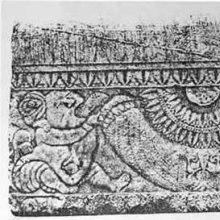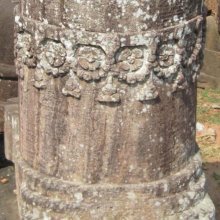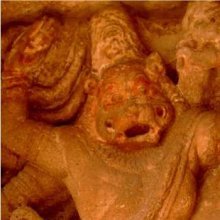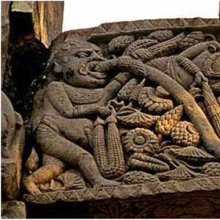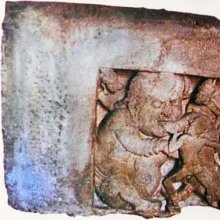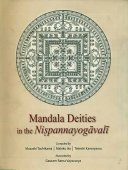Garland: 2 definitions
Introduction:
Garland means something in Hinduism, Sanskrit. If you want to know the exact meaning, history, etymology or English translation of this term then check out the descriptions on this page. Add your comment or reference to a book if you want to contribute to this summary article.
Images (photo gallery)
(+62 more images available)
In Hinduism
Purana and Itihasa (epic history)
Source: Shodhganga: Elements of Art and Architecture in the Trtiyakhanda of the VisnudharmottarapuranaGarlands were traditionally crafted by professional artisans, as part of the “sixty four kinds of Art”, according to the Kamasutra of Vatsyayana.—Cf. the Sanskrit Mālyagrathanavikalpa.—Indian tradition, basically includes sixty four Art forms are acknowledged. The history of Indian Art covers approximately five thousand years which presents a rich and almost continuous record. The references of sixty four kinds of Kala (कला, kalā) are found in the Bhagavatapurana, Shaiva-Tantras, Kamasutra of Vatsyayana etc.

The Purana (पुराण, purāṇas) refers to Sanskrit literature preserving ancient India’s vast cultural history, including historical legends, religious ceremonies, various arts and sciences. The eighteen mahapuranas total over 400,000 shlokas (metrical couplets) and date to at least several centuries BCE.
Natyashastra (theatrics and dramaturgy)
Source: Shodhganga: Elements of Art and Architecture in the Trtiyakhanda of the Visnudharmottarapurana (natya)1) Garlands and Ornaments (in Indian Dramas) form a part of the Alaṃkāra division of Āhāryābhinaya: one of the four divisions of Abhinaya or “ways to convey or represent one’s emotion to others”, according to the Viṣṇudharmottarapurāṇa, an ancient Sanskrit text which (being encyclopedic in nature) deals with a variety of cultural topics such as arts, architecture, music, grammar and astronomy.—Alaṃkāra deals with the decoration of garlands and ornaments. In the Nāṭyaśāstra four kinds of ornaments and five kinds of garlands are accepted. In the Sanskrit dramas ornaments like ear-rings, bracelets, head-gears etc. are seen to be collected from nature. This is informed in many of the Sanskrit dramas.
2) The Garland is associated with Kapittha-hasta: one of the twenty-two Single-hand Gestures (in Indian Dramas) (known as asaṃyuktahastas).—In the Śabdakalpadruma, the word kapittha is explained as a kind of tree where kapi i.e., monkey comes due to the greed of fruit. The word kapittha again denotes the fruit called wood apple. [...] This posture is used to denote sacrifice, holding of an umbrella or a garland or rope, dragging and fanning.

Natyashastra (नाट्यशास्त्र, nāṭyaśāstra) refers to both the ancient Indian tradition (shastra) of performing arts, (natya—theatrics, drama, dance, music), as well as the name of a Sanskrit work dealing with these subjects. It also teaches the rules for composing Dramatic plays (nataka), construction and performance of Theater, and Poetic works (kavya).
See also (Relevant definitions)
Starts with: Garland flower, Garland of flames, Garland of gold.
Ends with: Flower-garland, Garland of flames, Garland of gold, Pendant garland.
Full-text (+2250): Malya, Mala, Vanamala, Sraj, Malika, Sragdaman, Malaka, Pralamba, Sekhara, Pushpalava, Malini, Hara, Amshumala, Malakara, Torana, Dashamala, Gandhamalya, Vaijayanti, Srajishtha, Malin.
Relevant text
Search found 272 books and stories containing Garland; (plurals include: Garlands). You can also click to the full overview containing English textual excerpts. Below are direct links for the most relevant articles:
Cosmetics, Costumes and Ornaments in Ancient India (by Remadevi. O.)
1.3. Materials: Flowers < [Chapter 3 - Ornaments]
3. Ornaments for Different Occasions < [Chapter 3 - Ornaments]
2.1. Various other Head Ornaments < [Chapter 3 - Ornaments]
Manusmriti with the Commentary of Medhatithi (by Ganganatha Jha)
Verse 4.72 < [Section IX - Personal Cleanliness]
Verse 4.66 < [Section IX - Personal Cleanliness]
Verse 2.177 < [Section XXX - Rules to be observed by the Religious Student]
The Markandeya Purana (Study) (by Chandamita Bhattacharya)
Use of Cosmetics, Perfumes, Incense, etc. < [Chapter 2]
Hair Style < [Chapter 2]
4. Birth of Kālī from Ambikā’s Forehead < [Chapter 3]
Brihad Bhagavatamrita (commentary) (by Śrī Śrīmad Bhaktivedānta Nārāyana Gosvāmī Mahārāja)
Verse 2.4.66 < [Chapter 4 - Vaikuṇṭha (the spiritual world)]
Verse 2.1.132 < [Chapter 1 - Vairāgya (renunciation)]
Verse 1.2.81-83 < [Chapter 2 - Divya (the celestial plane)]
Trishashti Shalaka Purusha Caritra (by Helen M. Johnson)
Part 6: Malli’s childhood < [Chapter VI - Śrī Mallināthacaritra]
Part 7: Mahāvīra’s ten visions < [Chapter III - Mahāvīra’s first six years as an ascetic]
Part 2: Incarnation as Suvidhi (introduction) < [Chapter VII - Suvidhināthacaritra]
Tiruvaymoli (Thiruvaimozhi): English translation (by S. Satyamurthi Ayyangar)
Pasuram 4.2.3 < [Section 2 - Second Tiruvaymoli (Palan ay, El ulaku untu)]
Pasuram 6.8.4 < [Section 8 - Eighth Tiruvaymoli (Pon-ulaku aliro)]
Pasuram 4.3.4 < [Section 3 - Third Tiruvaymoli (Kovai Vayal)]
Related products

